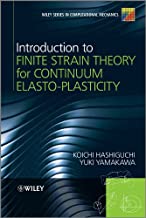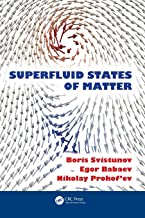Introduction to Finite Strain Theory for Continuum Elasto-Plasticity
Original price was: ₹12,853.80.₹10,283.04Current price is: ₹10,283.04.
ISBN: 9781119951858
Author/Editor: Koichi Hashiguchi
Publisher: John Wiley
Year: 2013
1 in stock (can be backordered)
Description
Comprehensive introduction to finite elastoplasticity, addressing various analytical and numerical analyses & including state-of-the-art theories Introduction to Finite Elastoplasticity presents introductory explanations that can be readily understood by readers with only a basic knowledge of elastoplasticity, showing physical backgrounds of concepts in detail and derivation processes of almost all equations. The authors address various analytical and numerical finite strain analyses, including new theories developed in recent years, and explain fundamentals including the push-forward and pull-back operations and the Lie derivatives of tensors. As a foundation to finite strain theory, the authors begin by addressing the advanced mathematical and physical properties of continuum mechanics. They progress to explain a finite elastoplastic constitutive model, discuss numerical issues on stress computation, implement the numerical algorithms for stress computation into large-deformation finite element analysis and illustrate several numerical examples of boundary-value problems.
Programs for the stress computation of finite elastoplastic models explained in this book are included in an appendix, and the code can be downloaded from an accompanying website.
Additional information
| Weight | 0.868 kg |
|---|
Product Properties
| Year of Publication | 2013 |
|---|---|
| Table of Contents | Preface xi Series Preface xv Introduction xvii 1 Mathematical Preliminaries 1 1.1 Basic Symbols and Conventions 1 1.2 Definition of Tensor 2 1.2.1 Objective Tensor 2 1.2.2 Quotient Law 4 1.3 Vector Analysis 5 1.3.1 Scalar Product 5 1.3.2 Vector Product 6 1.3.3 Scalar Triple Product 6 1.3.4 Vector Triple Product 7 1.3.5 Reciprocal Vectors 8 1.3.6 Tensor Product 9 1.4 Tensor Analysis 9 1.4.1 Properties of Second-Order Tensor 9 1.4.2 Tensor Components 10 1.4.3 Transposed Tensor 11 1.4.4 Inverse Tensor 12 1.4.5 Orthogonal Tensor 12 1.4.6 Tensor Decompositions 15 1.4.7 Axial Vector 17 1.4.8 Determinant 20 1.4.9 On Solutions of Simultaneous Equation 23 1.4.10 Scalar Triple Products with Invariants 24 1.4.11 Orthogonal Transformation of Scalar Triple Product 25 1.4.12 Pseudo Scalar, Vector and Tensor 26 1.5 Tensor Representations 27 1.5.1 Tensor Notations 27 1.5.2 Tensor Components and Transformation Rule 27 1.5.3 Notations of Tensor Operations 28 1.5.4 Operational Tensors 29 1.5.5 Isotropic Tensors 31 1.6 Eigenvalues and Eigenvectors 36 1.6.1 Eigenvalues and Eigenvectors of Second-Order Tensors 36 1.6.2 Spectral Representation and Elementary Tensor Functions 40 1.6.3 Calculation of Eigenvalues and Eigenvectors 42 1.6.4 Eigenvalues and Vectors of Orthogonal Tensor 45 1.6.5 Eigenvalues and Vectors of Skew-Symmetric Tensor and Axial Vector 46 1.6.6 Cayley Hamilton Theorem 47 1.7 Polar Decomposition 47 1.8 Isotropy 49 1.8.1 Isotropic Material 49 1.8.2 Representation Theorem of Isotropic Tensor-Valued Tensor Function 50 1.9 Differential Formulae 54 1.9.1 Partial Derivatives 54 1.9.2 Directional Derivatives 59 1.9.3 Taylor Expansion 62 1.9.4 Time Derivatives in Lagrangian and Eulerian Descriptions 63 1.9.5 Derivatives of Tensor Field 68 1.9.6 Gauss s Divergence Theorem 71 1.9.7 Material-Time Derivative of Volume Integration 73 1.10 Variations and Rates of Geometrical Elements 74 1.10.1 Variations of Line, Surface and Volume 75 1.10.2 Rates of Changes of Surface and Volume 76 1.11 Continuity and Smoothness Conditions 79 1.11.1 Continuity Condition 79 1.11.2 Smoothness Condition 80 1.12 Unconventional Elasto-Plasticity Models 81 2 General (Curvilinear) Coordinate System 85 2.1 Primary and Reciprocal Base Vectors 85 2.2 Metric Tensors 89 2.3 Representations of Vectors and Tensors 95 2.4 Physical Components of Vectors and Tensors 102 2.5 Covariant Derivative of Base Vectors with Christoffel Symbol 103 2.6 Covariant Derivatives of Scalars, Vectors and Tensors 107 2.7 Riemann Christoffel Curvature Tensor 112 2.8 Relations of Convected and Cartesian Coordinate Descriptions 115 3 Description of Physical Quantities in Convected Coordinate System 117 3.1 Necessity for Description in Embedded Coordinate System 117 3.2 Embedded Base Vectors 118 3.3 Deformation Gradient Tensor 121 3.4 Pull-Back and Push-Forward Operations 123 4 Strain and Strain Rate Tensors 131 4.1 Deformation Tensors 131 4.2 Strain Tensors 136 4.2.1 Green and Almansi Strain Tensors 136 4.2.2 General Strain Tensors 141 4.2.3 Hencky Strain Tensor 144 4.3 Compatibility Condition 145 4.4 Strain Rate and Spin Tensors 146 4.4.1 Strain Rate and Spin Tensors Based on Velocity Gradient Tensor 147 4.4.2 Strain Rate Tensor Based on General Strain Tensor 152 4.5 Representations of Strain Rate and Spin Tensors in Lagrangian and Eulerian Triads 153 4.6 Decomposition of Deformation Gradient Tensor into Isochoric and Volumetric Parts 158 5 Convected Derivative 161 5.1 Convected Derivative 161 5.2 Corotational Rate 165 5.3 Objectivity 166 6 Conservation Laws and Stress (Rate) Tensors 179 6.1 Conservation Laws 179 6.1.1 Basic Conservation Law 179 6.1.2 Conservation Law of Mass 180 6.1.3 Conservation Law of Linear Momentum 181 6.1.4 Conservation Law of Angular Momentum 182 6.2 Stress Tensors 183 6.2.1 Cauchy Stress Tensor 183 6.2.2 Symmetry of Cauchy Stress Tensor 187 6.2.3 Various Stress Tensors 188 6.3 Equilibrium Equation 194 6.4 Equilibrium Equation of Angular Moment 197 6.5 Conservation Law of Energy 197 6.6 Virtual Work Principle 199 6.7 Work Conjugacy 200 6.8 Stress Rate Tensors 203 6.8.1 Contravariant Convected Derivatives 203 6.8.2 Covariant Contravariant Convected Derivatives 204 6.8.3 Covariant Convected Derivatives 204 6.8.4 Corotational Convected Derivatives 204 6.9 Some Basic Loading Behavior 207 6.9.1 Uniaxial Loading Followed by Rotation 207 6.9.2 Simple Shear 215 6.9.3 Combined Loading of Tension and Distortion 220 7 Hyperelasticity 225 7.1 Hyperelastic Constitutive Equation and Its Rate Form 225 7.2 Examples of Hyperelastic Constitutive Equations 230 7.2.1 St. Venant Kirchhoff Elasticity 230 7.2.2 Modified St. Venant Kirchhoff Elasticity 231 7.2.3 Neo-Hookean Elasticity 232 7.2.4 Modified Neo-Hookean Elasticity (1) 233 7.2.5 Modified Neo-Hookean Elasticity (2) 234 7.2.6 Modified Neo-Hookean Elasticity (3) 234 7.2.7 Modified Neo-Hookean Elasticity (4) 234 8 Finite Elasto-Plastic Constitutive Equation 237 8.1 Basic Structures of Finite Elasto-Plasticity 238 8.2 Multiplicative Decomposition 238 8.3 Stress and Deformation Tensors for Multiplicative Decomposition 243 8.4 Incorporation of Nonlinear Kinematic Hardening 244 8.4.1 Rheological Model for Nonlinear Kinematic Hardening 245 8.4.2 Multiplicative Decomposition of Plastic Deformation Gradient Tensor 246 8.5 Strain Tensors 249 8.6 Strain Rate and Spin Tensors 252 8.6.1 Strain Rate and Spin Tensors in Current Configuration 252 8.6.2 Contravariant Covariant Pulled-Back Strain Rate and Spin Tensors in Intermediate Configuration 254 8.6.3 Covariant Pulled-Back Strain Rate and Spin Tensors in Intermediate Configuration 256 8.6.4 Strain Rate Tensors for Kinematic Hardening 259 8.7 Stress and Kinematic Hardening Variable Tensors 261 8.8 Influences of Superposed Rotations: Objectivity 266 8.9 Hyperelastic Equations for Elastic Deformation and Kinematic Hardening 268 8.9.1 Hyperelastic Constitutive Equation 268 8.9.2 Hyperelastic Type Constitutive Equation for Kinematic Hardening 269 8.10 Plastic Constitutive Equations 270 8.10.1 Normal-Yield and Subloading Surfaces 271 8.10.2 Consistency Condition 272 8.10.3 Plastic and Kinematic Hardening Flow Rules 275 8.10.4 Plastic Strain Rate 277 8.11 Relation between Stress Rate and Strain Rate 278 8.11.1 Description in Intermediate Configuration 278 8.11.2 Description in Reference Configuration 278 8.11.3 Description in Current Configuration 279 8.12 Material Functions of Metals 280 8.12.1 Strain Energy Function of Elastic Deformation 280 8.12.2 Strain Energy Function for Kinematic Hardening 281 8.12.3 Yield Function 282 8.12.4 Plastic Strain Rate and Kinematic Hardening Strain Rate 283 8.13 On the Finite Elasto-Plastic Model in the Current Configuration by the Spectral Representation 284 8.14 On the Clausius Duhem Inequality and the Principle of Maximum Dissipation 285 9 Computational Methods for Finite Strain Elasto-Plasticity 287 9.1 A Brief Review of Numerical Methods for Finite Strain Elasto-Plasticity 288 9.2 Brief Summary of Model Formulation 289 9.2.1 Constitutive Equations for Elastic Deformation and Isotropic and Kinematic Hardening 289 9.2.2 Normal-Yield and Subloading Functions 291 9.2.3 Plastic Evolution Rules 291 9.2.4 Evolution Rule of Normal-Yield Ratio for Subloading Surface 293 9.3 Transformation to Description in Reference Configuration 293 9.3.1 Constitutive Equations for Elastic Deformation and Isotropic and Kinematic Hardening 293 9.3.2 Normal-Yield and Subloading Functions 294 9.3.3 Plastic Evolution Rules 295 9.3.4 Evolution Rule of Normal-Yield Ratio for Subloading Surface 296 9.4 Time-Integration of Plastic Evolution Rules 296 9.5 Update of Deformation Gradient Tensor 300 9.6 Elastic Predictor Step and Loading Criterion 301 9.7 Plastic Corrector Step by Return-Mapping 304 9.8 Derivation of Jacobian Matrix for Return-Mapping 308 9.8.1 Components of Jacobian Matrix 308 9.8.2 Derivatives of Tensor Exponentials 310 9.8.3 Derivatives of Stresses 312 9.9 Consistent (Algorithmic) Tangent Modulus Tensor 312 9.9.1 Analytical Derivation of Consistent Tangent Modulus Tensor 313 9.9.2 Numerical Computation of Consistent Tangent Modulus Tensor 315 9.10 Numerical Examples 316 9.10.1 Example 1: Strain-Controlled Cyclic Simple Shear Analysis 318 9.10.2 Example 2: Elastic Plastic Transition 318 9.10.3 Example 3: Large Monotonic Simple Shear Analysis with Kinematic Hardening Model 320 9.10.4 Example 4: Accuracy and Convergence Assessment of Stress-Update Algorithm 322 9.10.5 Example 5: Finite Element Simulation of Large Deflection of Cantilever 326 9.10.6 Example 6: Finite Element Simulation of Combined Tensile, Compressive, and Shear Deformation for Cubic Specimen 330 10 Computer Programs 337 10.1 User Instructions and Input File Description 337 10.2 Output File Description 340x Contents 10.3 Computer Programs 341 10.3.1 Structure of Fortran Program returnmap 341 10.3.2 Main Routine of Program returnmap 343 10.3.3 Subroutine to Define Common Variables: comvar 343 10.3.4 Subroutine for Return-Mapping: retmap 345 10.3.5 Subroutine for Isotropic Hardening Rule: plhiso 377 10.3.6 Subroutine for Numerical Computation of Consistent Tangent Modulus Tensor: tgnum0 377 A Projection of Area 385 B Geometrical Interpretation of Strain Rate and Spin Tensors 387 C Proof for Derivative of Second Invariant of Logarithmic-Deviatoric Deformation Tensor 391 D Numerical Computation of Tensor Exponential Function and Its Derivative 393 D.1 Numerical Computation of Tensor Exponential Function 393 D.2 Fortran Subroutine for Tensor Exponential Function: matexp 394 D.3 Numerical Computation of Derivative of Tensor Exponential Function 396 D.4 Fortran Subroutine for Derivative of Tensor Exponential Function: matdex 400 References 401 Index 409 |
| Author | Koichi Hashiguchi |
| ISBN/ISSN | 9781119951858 |
| Binding | Hardback |
| Edition | 1 |
| Publisher | John Wiley |
You must be logged in to post a review.






Reviews
There are no reviews yet.